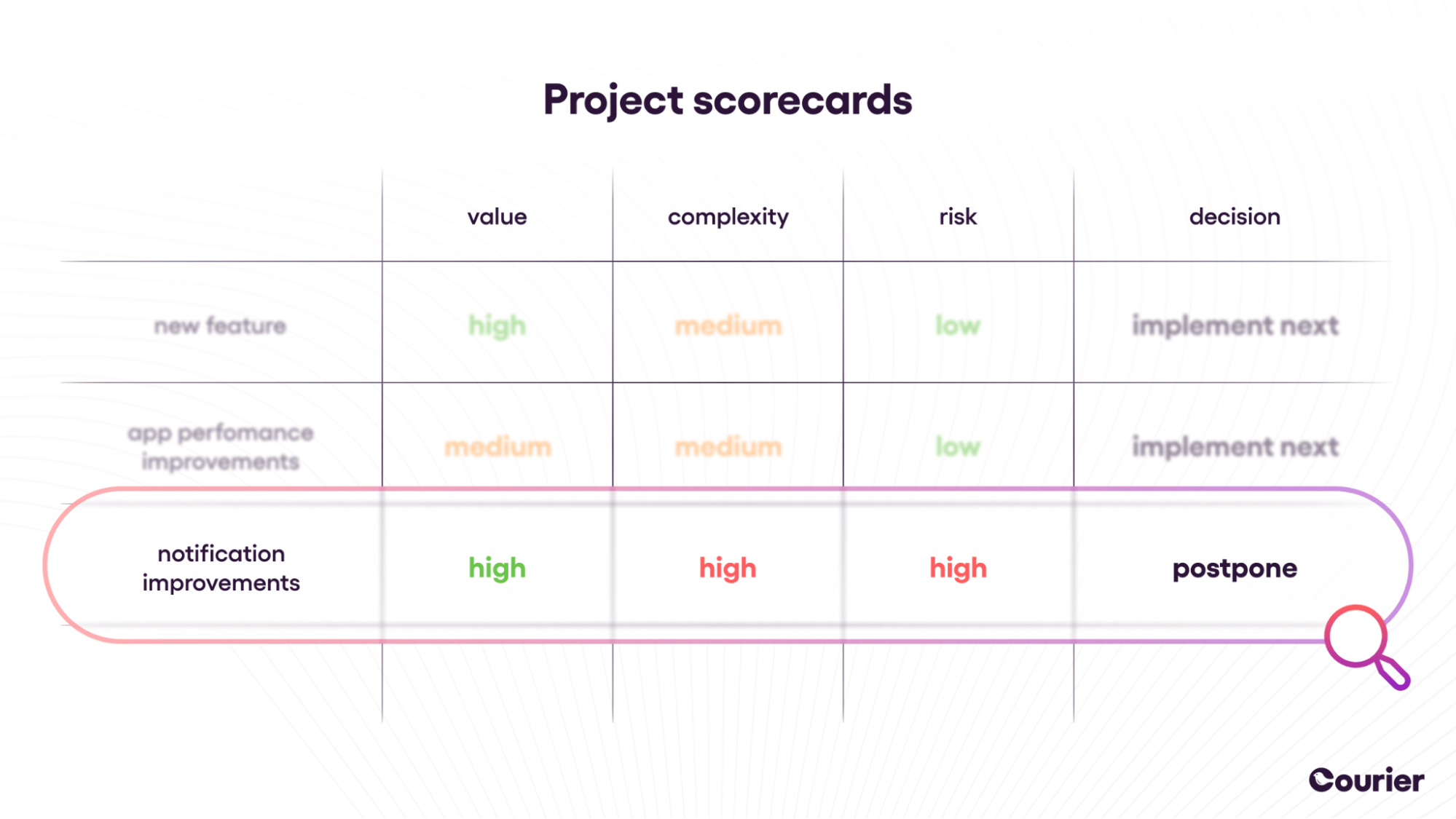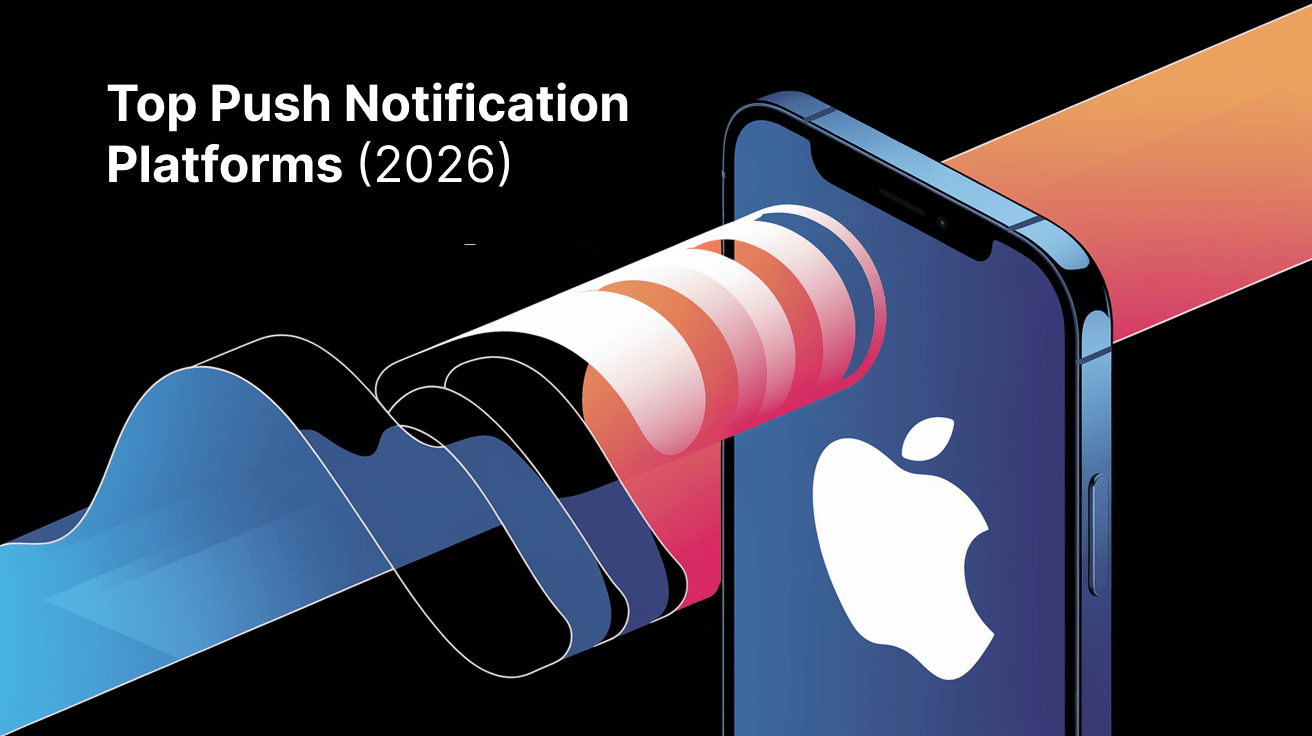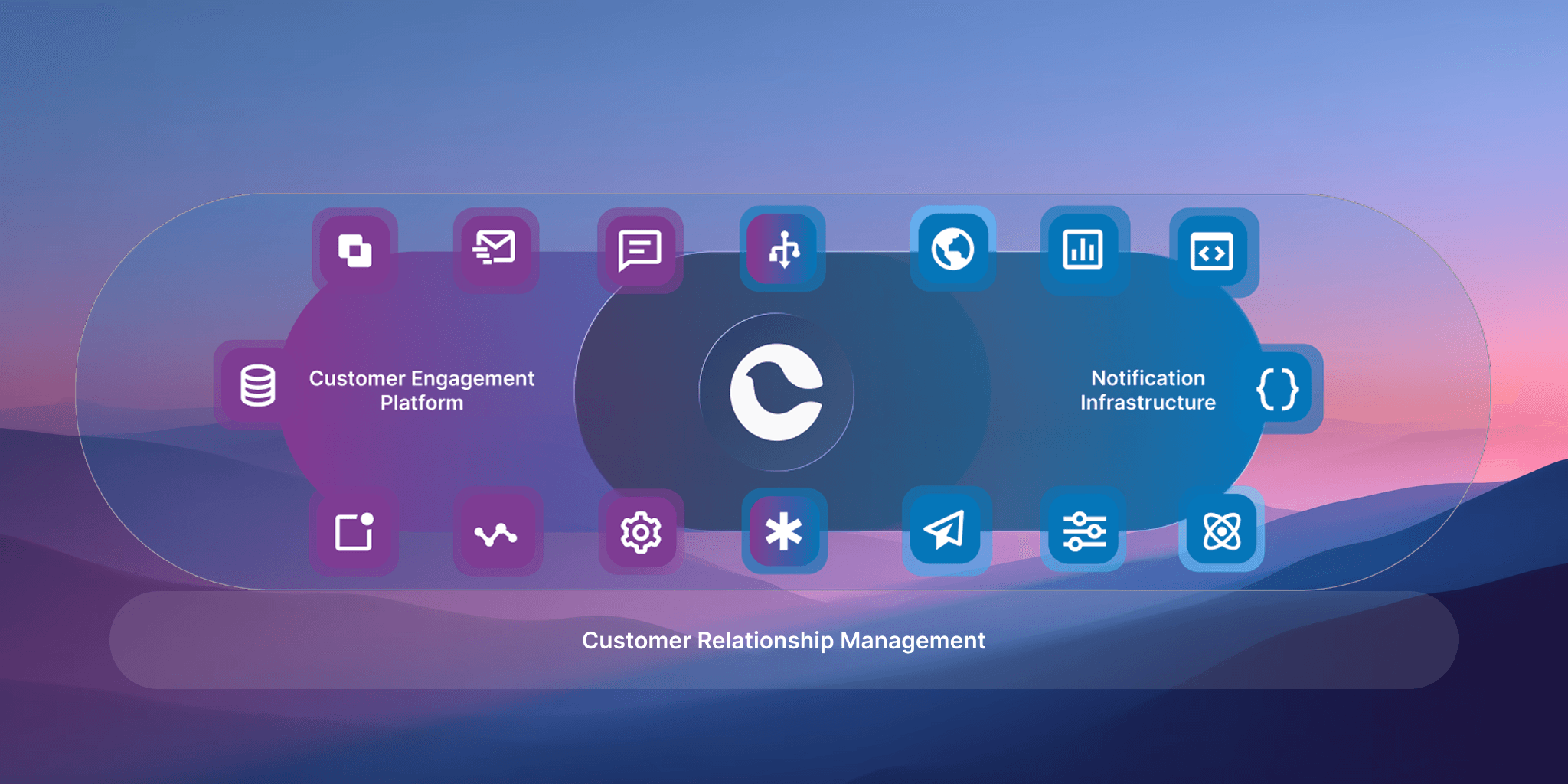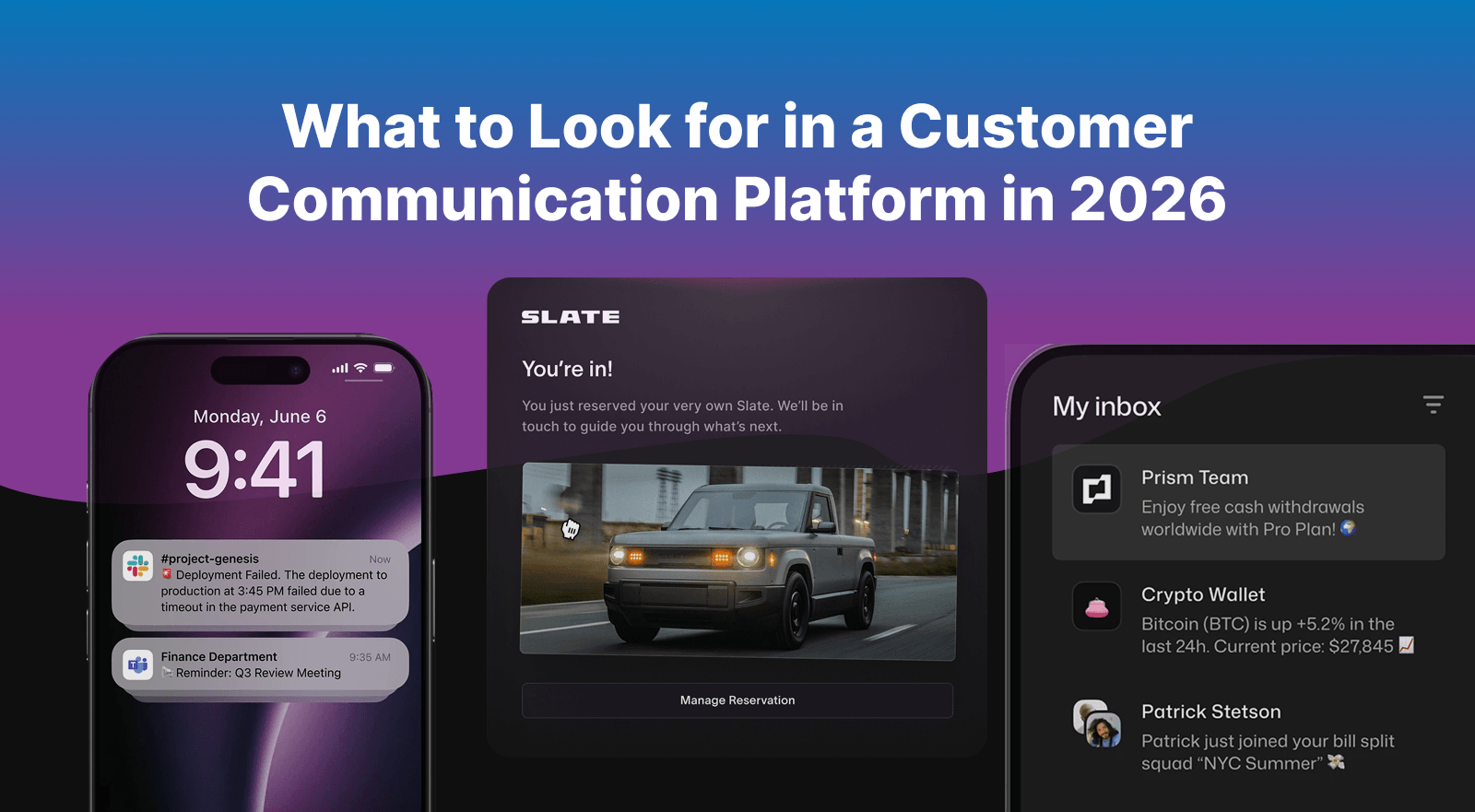The Product Manager's Guide To Building Notification Systems: Decoupling Templates From Code
Anwesa Chatterjee
September 23, 2022

Table of contents
Why PMs believe notification projects are hard
The limits of common engineering solutions to notification problems
Even a custom notification system is a bottleneck for notification improvements
The result: notifications rarely get updated
There is a better way: enable PMs to work with notifications without involving the engineering team
What are the results of PM enablement?
So, how can you enable PMs to work with notifications?
Courier can help
- Part 1: Product Notification Experience
- Part 3: User Preferences Management
- Part 4: Omni-Channel Analytics
- Part 5: Optimized Automation Logic
As a product manager, have you ever had to say no to improving your app’s notifications because of how complex the project seemed?
If yes, you’re not alone. At Courier, we frequently see product teams deciding not to work on notifications. And PMs aren’t making that decision because a good notification experience is not important for their SaaS product or service — quite the opposite.
The reason is that changing notifications, in their experience, requires a lot of work between engineering and product due to how closely the notifications are tied to the rest of the application. If PMs are tasked with adding a new email campaign that all new users of the app will receive, that can usually be done outside of the core app. But sending more unique notifications, like alerting a Slack channel when someone @-mentions their colleague in a shared file, can be complex and require significant engineering work. And still more work is needed when the text or the design of such a notification needs to be updated.
We believe that changing notifications doesn’t have to be so difficult. In this article, we explain how decoupling notifications from your application’s codebase can help make notification projects less complex and less risky for product teams.
Why PMs believe notification projects are hard

Usually, the task of improving an app’s notification experience — like adding or changing notifications, or connecting additional notification channels — falls to the engineering team that’s responsible for the main product. Such teams have lots on their plate, which makes it necessary to prioritize some tasks over others.
Notification projects tend to be high-value for product managers, as a bad notification experience can have a negative impact on a SaaS app’s customer base, while, conversely, a good notification experience can drive growth metrics and delight customers.
However, notification projects also score high on complexity and risk at most companies. That’s because different notification channels, which are quite different by nature (think email versus mobile push), require a lot of individual engineering.
With so much complexity involved, product managers have to make a tough call: is it really worth taking on notification work when there are easier projects to work on with more tangible benefits? Because task backlogs frequently have other items in them that don’t carry as much complexity or risk, it’s logical for product managers to postpone rather complex notification projects. And so notification projects get moved down the priority list, again and again.
The limits of common engineering solutions to notification problems
To try and make notification changes less difficult to implement, engineering teams use open-source tools that are well supported within their framework or programming language of choice. For example, those working with Ruby on Rails applications often use Rails’ built-in email sending module, Action Mailer, which includes functionality for sending plain-text and HTML emails.
While tools like Action Mailer are convenient to use and well-maintained, they can’t handle more complex tasks like expanding beyond the standard notification channels. If you want to add Slack or SMS notifications, for example, choices like Action Mailer can become a limiting factor, rather than an enabler of new product functionality.
The next logical option for a software team running into tooling limitations is to go with a fully customized notification system — but such a system brings its own challenges.
Even a custom notification system is a bottleneck for notification improvements
It may seem that the solution to the limitations of open-source tools is to simply build your own custom notification system. But a custom notification system is still code that implements notification logic, supported channels, and templates for specific notifications, and this code lives inside the application codebase in a version control system like Git. Any changes to this part of the codebase have to follow the steps of the software development process, which becomes cumbersome when making many small changes, as is the case with notifications. (Not to mention that engineering time needs to be allocated to the maintenance of such systems in the long run.)
For example, if the task is to update the wording or the design of a notification across all channels, the engineering team tasked with the work might have to:
- Change the HTML email template.
- Change the Slack notification template.
- Change the Microsoft Teams notification template.
- Test all three changes.
- Wait for code review on the changes.
- Once the code is reviewed, deploy all three changes to production.
- Hand off to the PM for a final confirmation.
And every time a PM wants more changes implemented for notifications, the process has to start over again, even for trivial content changes. The standard development process, which is totally reasonable for code changes, is too much overhead when working on notifications, and the additional overhead takes the engineers’ time away from working on more valuable things.
The result: notifications rarely get updated
Because of the additional delays introduced by the development process, the friction for implementing notification changes ends up being so high that PMs often choose to not implement notification changes at all.
Instead of focusing on building the best possible notification experience, they settle for the default notifications that are built into their application already, because anything else becomes too difficult to do. They might think “If it took two weeks to change the simple design on my notifications, we're just not going to change things anymore.” And so notification experiences stall out indefinitely.
There is a better way: enable PMs to work with notifications without involving the engineering team
Courier’s point of view is that the way notifications are handled in most SaaS apps today — templates stored in code, notification functionality changes requiring code deployments, etc. — is outdated and, as we have seen in the examples above, ineffective.
Instead of having to go through the development process for each notification change, we need to give PMs and other non-technical stakeholders the right tools to work with notifications directly. Here are the core practices that act as enablers for non-technical audiences.
Making templates accessible to non-engineers. Notification templates in the form of text, HTML, or programming-language-specific template files need to be located outside of the application code, and PMs as well as other non-technical teams need to have access and be able to make changes.
Making notification logic configurable without needing to re-deploy the app. The logic involved in deciding which notifications to send when should not be located in the application code, but rather sit next to it and be configurable without needing to deploy the application. The configuration can live in a text file, a web interface, or another config format. PMs should ideally be able to change the configuration themselves.
Enabling self-serve analytics. Besides notification functionality, PMs need to be able to track how their changes are doing — and be able to follow the statistics without the need to ask engineering or data teams for the numbers. Analytics can be presented as a custom dashboard, but can also be an export of a business intelligence report, or even a dump of application logs that show which messages were sent, depending on which option is easier.
What are the results of PM enablement?
To show that PM enablement works as a way to make notification projects easier, we want to share two examples from Courier customers that have experienced this change.
Bluecrew, a marketplace for hourly jobs, has seen its business grow after decoupling notifications from application code. The company was able to improve the onboarding experience for new users in part by taking advantage of notification templates and making them accessible to non-technical stakeholders.
Within Bluecrew’s notification system, “anyone can add a content block and insert a custom attribute like ‘shift start time’ or ‘cancelation reason.’ We also have the flexibility to add custom code anywhere in the notification,” says Cooper Newby, the Chief Product Officer at Bluecrew.
Another company that’s been taking advantage of the enablement approach is Expel, a provider of security services. The Expel team has enabled its UX designers to use the template designer UI directly and make changes to the product in real time.
“We can get our UX designers working directly on the templates and we can make updates and have them live in seconds,” says Yousuf Ashparie, Principal Software Engineer at Expel.
Does enabling PMs to make notification changes sound appealing at this point? We hope it does — as we believe it’s a significant improvement over the current practices at most companies. Let’s look at how you can enable PMs to work with notifications in your own team.
So, how can you enable PMs to work with notifications?
Looking to enable PMs to do more notification work, but not sure where to start? Here are our top recommendations for companies looking to get started on the PM enablement journey.
1. Get analytics in place. Having analytics for notifications is a key tool for PMs to measure any notification changes. While metrics can be difficult to come by for some notification channels, it is usually possible to have at least some numbers in place. Once the PMs get the data, they can use it to avoid accidentally making the notification experience worse, and to make sure the rest of the organization can see the benefits for larger changes to notifications.
2. Make it easier to change notification templates. While it’s ideal to make all notification channels and notification types configurable by PMs, it’s not always realistic. Instead, at least make it so that PMs can change existing notifications without much involvement from the engineering team. Even if that’s all you allow, you will still need to add functionality to adjust notification designs to fit the updated content, and likely implement internationalization and translation workflows if you’re interested in supporting multiple languages.
3. Build guardrails to prevent notification issues from escaping to production. Ideally, all notification functionality should be covered with automated and, possibly, manual tests so that the organization can be confident in the product’s notification experience at all times. The areas to check include: notification text fitting within the display area; possible internationalization glitches; technical issues like app crashes resulting from changes in notification text size; handling of unexpected characters if notifications include user input.
Courier can help
Instead of building everything yourself, use Courier — and get our recommended steps 1–3 done almost instantly after some brief initial implementation work.
Using Courier frees up your team to focus on other valuable things in their backlog. For PMs, UX designers, and other non-technical stakeholders, Courier helps by:
- providing a drag and drop designer, including a staging environment, with the ability to make changes live without deploying the app
- offering a UI that allows users to add new notification channels without needing to update code
- including an Automation UI that allows users to build out notification workflows visually (no application code)
- Implementing the guardrails in point 3 above, so that you can reduce the effort involved in changing notifications without increasing the risk.
Similar resources

Top Push Notification Platforms For Product Teams To Boost Engagement In 2026
Push notifications drive 182% higher session rates when done right. This guide evaluates 12 platforms—including Courier, OneSignal, Firebase, Braze, and CleverTap—on delivery reliability, cross-channel orchestration, and developer effort. Learn which unified notification platform eliminates vendor sprawl while giving product teams the flexibility to ship notifications in days instead of months. We compare free tiers, pricing models, and key gaps each platform has compared to unified notification infrastructure.
By Kyle Seyler
January 09, 2026

Customer Engagement Platform vs CRM: Key Differences Explained
A CRM stores customer data: contacts, purchases, support tickets, and pipeline. It answers "who are our customers?" A customer engagement platform (CEP) orchestrates communication across email, push, SMS, in-app, and chat. It answers "what should we tell them next?" CRMs focus on historical records. CEPs process real-time behavior and trigger messages based on actions. Most teams need both, plus a third layer: notification infrastructure for reliable multi-channel delivery. Courier bridges CEP and infrastructure by combining routing, failover, and delivery tracking with engagement features like preference management, visual templates, and in-app notification centers.
By Kyle Seyler
January 07, 2026

Customer Communication Platforms: What to Look for in 2026
Customer communication has evolved beyond batch-and-blast campaigns. Modern platforms must handle real-time event triggers, smart channel routing, visual journey orchestration, and compliance across multiple channels. This guide breaks down what to look for when evaluating customer communication platforms in 2026. We cover B2B customer journeys, business messaging (Slack, Teams, WhatsApp), drop-in preference centers, CDP integration, and analytics that actually help you improve. Includes comparisons of Courier, Customer.io, Braze, and infrastructure-first alternatives.
By Kyle Seyler
December 23, 2025
© 2026 Courier. All rights reserved.